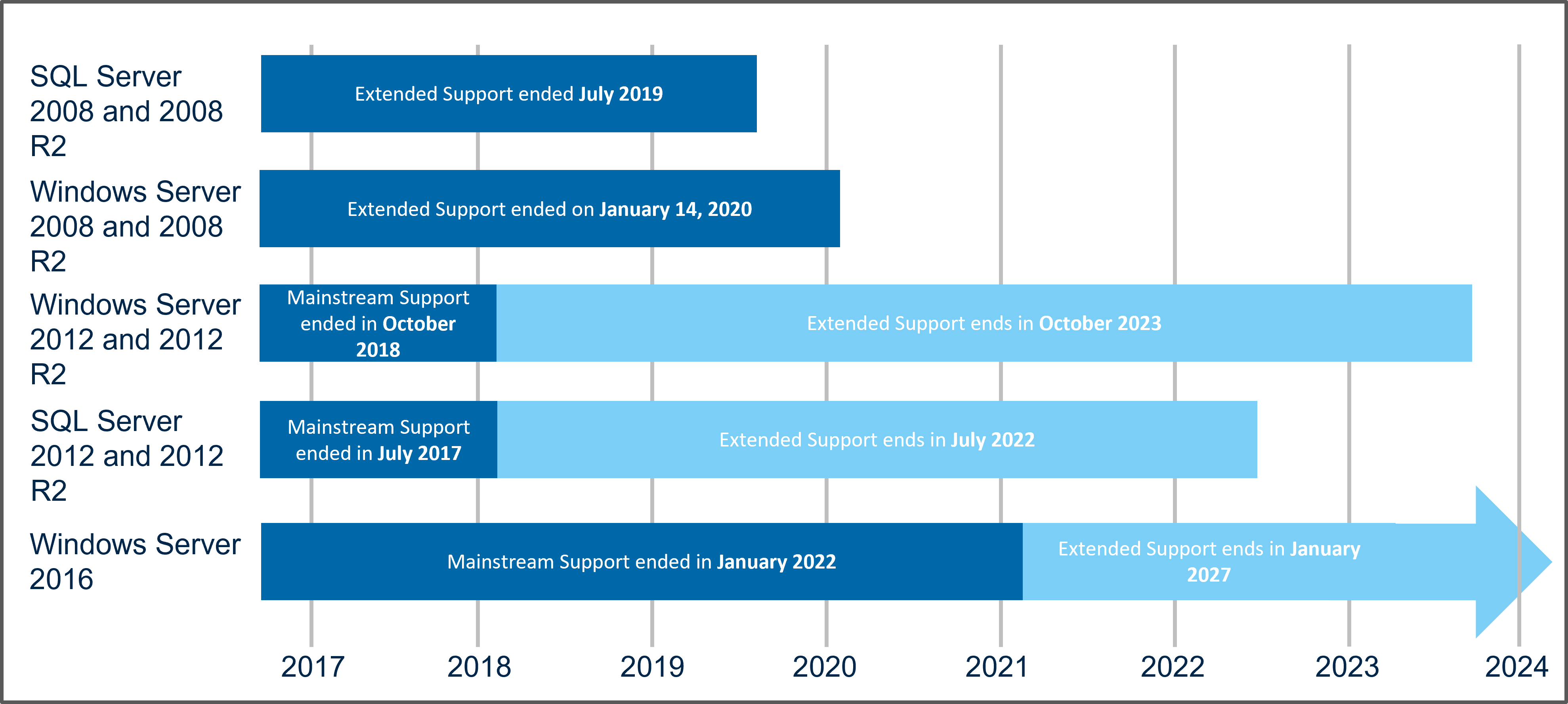
What to Do When IT Services Run Out of Maintenance?
Possible options for End of Life Windows 2012
On October 10, 2023, the support period for Windows Server 2012 and Windows Server 2012 R2 ends and thus also becomes a so-called "Outdated Component". This also applies to SQL Server 2012 and SQL Server 2012 R2, for which support will even end on July 12, 2022.
Also affected is the period of extended support for Windows Server 2008 R2 and Windows Server 2008, which ended on January 14, 2020. Since then, this version has represented a significant security risk for all companies.
Security Risks Due to the End of Life of IT Components
If IT components whose end of life has been reached continue to be operated, this results in a risk to the security of the systems: Corresponding security patches are no longer provided by the manufacturer for unsupported versions. In particular, already known vulnerabilities cause security incidents: for example, in about 99% of all cases, companies already know about risk more than 12 months before they become the target of cyberattacks.
In principle, Windows Server 2012 and Windows Server 2012 R2 users should now upgrade existing systems to a newer - or preferably the latest - version. Plans do not need to be progressively upgraded to deploy the latest server version. Microsoft offers the option to upgrade directly to the Windows Server 2019 version through a so-called " in-place upgrade." The 2016 version can thus be skipped.
Microsoft does not recommend a direct upgrade to version 2022. The new server software has long been available to ensure security and bring many useful new functions. The new Windows Server 2022 is the best example of this!
Options for End of Life of Windows 2012 and Windows 2012 R2 Systems as well as SQL Server 2012 and SQL Server 2012 R2
There are three different approaches to dealing with outdated components.
1. Upgrade without technology change
Invest in your existing on-premises IT infrastructure and make necessary upgrades.
2. Upgrade with technology change
See outdated components as an opportunity to migrate your servers, applications, and workloads to the cloud without significantly changing the application and underlying infrastructure.
3. Upgrade with a complete modernization of the application architecture
See outdated components as an opportunity to modernize your servers, applications, and workloads from the ground up with cloud services. With this transition to the cloud, you will save IT costs and benefit from the growing efficiency of your applications and processes.

Are you looking for a concrete solution to modernize your outdated components Windows 2012 and Windows 2012 R2 Systems as well as SQL Server 2012 and SQL Server 2012 R2?
1. Upgrade without technology change
In this procedure, a new server in the latest or a more recent version is set up parallel to the existing system. The application is installed on the new system, and relevant application data is transferred to the new system using "Backup & Restore". After a successful test, the delta is copied, and the old system is switched off as the new system takes over.
2. Upgrade without technology change (In Place Upgrade)
The significant advantage of this upgrade scenario is that the system itself is not changed. Thus, there will be no new IP address, and other authorizations and accesses will remain the same. However, a "rollback" scenario should be defined in advance, and testing should not be underestimated.
3. No upgrade without technology change
The Extended Security Update (ESU) program is a final option for customers who need to run certain older Microsoft products after support expires. It includes critical and/or essential security updates for three years after the end date of extended support for the product. Comprehensive security updates are distributed when available. ESUs do not include new features or security-related updates.
4. No upgrade with technology change
Migrating to Microsoft Azure gives you more time to plan a complete application architecture modernization. To do this, Microsoft is offering free extended security updates for three more years after the deadline for Windows Server 2012 and 2012 R2 and SQL Server 2012. You can combine this with Azure Hybrid Benefit to get significant savings on Azure by leveraging existing on-premises SQL Server and Windows Server licenses in the cloud at no additional cost.
5. Upgrade with complete modernization of the application architecture
With this transition to the cloud, you save IT costs, keep IT costs, and benefit from the growing efficiency of your applications and processes. Especially if companies have already completed the first lift & shift migrations to the cloud, there is still a lot of potential lying dormant in the systems. This applies particularly to on-premises applications, which benefit significantly from application modernization after a successful cloud transformation. Outdated components" in particular can be your so-called low-hanging fruit for modernizing the application architecture.
Resources
- https://docs.microsoft.com/en-us/lifecycle/products/windows-server-2008-r2
- https://news.microsoft.com/de-de/support-ende-windows-server-2008-und-sql-server-2008/ (in German language)
- https://docs.microsoft.com/en-us/lifecycle/products/microsoft-sql-server-2012
- https://docs.microsoft.com/en-us/lifecycle/products/windows-server-2012-r2
- https://docs.microsoft.com/en-us/lifecycle/products/windows-server-2016
Written by



